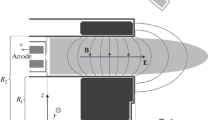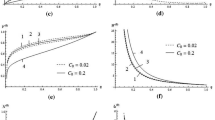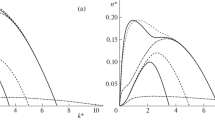Abstract
Stationary and unstable pulsating flows of ionizing hydrogen in the channel of a quasi-stationary plasma accelerator are considered. Numerical studies of two-dimensional axisymmetric flows are carried out based on the modified magnetogasdynamic (MGD) equations in the approximation of local thermodynamic equilibrium, taking into account electrical conductivity, thermal conductivity, and radiation transport. The generalization of the calculation results led to the formulation of the empirical condition for the stationarity of two-dimensional flows of an ionizing gas.








Similar content being viewed by others
RЕFERENCES
S. I. Braginskii, “Transfer phenomena in plasma,” in Problems in the Theory of Plasma, Issue 1, Ed. by M. A. Leontovich (Gosatomizdat, Moscow, 1963), pp. 183–272 [in Russian]; English transl.: S. I. Braginskii, “Transport processes in plasma,” in Reviews of Plasma Physics, Vol. 1, Ed. by M. A. Leontovich (Consultants Bureau, New York, 1965), pp. 205–311.
Ya. B. Zel’dovich and Yu. P. Raizer, Physics of Shock Waves and High-Temperature Hydrodynamic Phenomena (Nauka, Moscow, 1966; Dover, Mineola, NY, 2002).
N. A. Krall and A. W. Trivelpiece, Principles of Plasma Physics (McGraw-Hill, New York, 1973).
A. I. Morozov, Introduction to Plasma Dynamics (Fizmatlit, Moscow, 2008; CRC Press, Boca Raton, FL, 2013).
A. I. Morozov, “Principles of coaxial (quasi)stationary plasma accelerators (QSPA),” Sov. J. Plasma Phys. 16, 63–78 (1990).
N. Klimov, V. Podkovyrov, A. Zhitlukhin, D. Kovalenko et al., “Experimental study of PFCs erosion under ITER-like transient loads at plasma gun facility QSPA,” J. Nucl. Mater. 390–391, 721–726 (2009). https://doi.org/10.1016/j.jnucmat.2009.01.197
A. N. Kozlov, S. P. Drukarenko, N. S. Klimov, A. A. Moskacheva, and V. L. Podkovyrov, “The experimental research of the electric characteristics of discharge in the quasi-steady plasma accelerator with the longitudinal magnetic field,” Vopr. At. Nauki Tekh., Ser.: Fiz. Plazmy, No. 1, 92–94 (2009).
N. S. Klimov, D. V. Kovalenko, V. L. Podkovyrov, D. M. Kochnev, A. D. Yaroshevskaya, R. V. Urlova, A. N. Kozlov, and V. S. Konovalov, “Experimental study of integrated characteristics of plasma stream and discharge of a quasi-stationary high-current plasma accelerator with its own magnetic field,” Vopr. At. Nauki Tekh., Ser.: Termoyad. Sint. 42 (3), 52–63 (2019). https://doi.org/10.21517/0202-3822-2019-42-3-52-63
V. I. Tereshin, A. N. Bandura, O. V. Byrka, V. V. Chebotarev, I. E. Garkusha, I. Landman, V. A. Makhlaj, I. M. Neklyudov, D. G. Solyakov, and A. V. Tsarenko, “Application of powerful quasi-steady-state plasma accelerators for simulation of ITER transient heat loads on divertor surfaces,” Plasma Phys. Controlled Fusion 49 (5A), A231–A239 (2007). https://doi.org/10.1088/0741-3335/49/5A/S19
I. E. Garkusha, V. V. Chebotarev, S. S. Herashchenko, V. A. Makhlaj, et al., “Novel test-bed facility for PSI issues in fusion reactor conditions on the base of next generation QSPA plasma accelerator,” Nucl. Fusion 57 (11), 116011 (2017). https://doi.org/10.1088/1741-4326/aa7924
I. E. Garkusha, D. G. Solyakov, V. V. Chebotarev, V. A. Makhlay, and N. V. Kulik, “Experimental studies of high-energy quasi-steady plasma streams generated by a magnetoplasma analogue of the Laval nozzle in the compression and acceleration regimes,” Plasma Phys. Rep. 45 (2), 166–178 (2019). https://doi.org/10.1134/S1063780X19010057
V. M. Astashynski, S. I. Ananin et al., “Materials surface modification using quasi-stationary plasma accelerators,” Surf. Coat. Technol. 180–181, 392–395 (2004). https://doi.org/10.1016/j.surfcoat.2003.10.098
K. V. Brushlinskii and A. I. Morozov, “Calculation of two-dimensional plasma flows in channels,” in Reviews of Plasma Physics, Vol. 8, Ed. by M. A. Leontovich (Springer, New York, 1980), pp. 105–198. https://doi.org/10.1007/978-1-4615-7814-7_2
K. V. Brushlinskii, A. M. Zaborov, A. N. Kozlov, A. I. Morozov, and V. V. Savelyev, “Numerical simulation of plasma flows in QSPA,” Sov. J. Plasma Phys. 16, 79–89 (1990).
A. N. Kozlov and V. S. Konovalov, “Numerical study of the ionization process and radiation transport in the channel of plasma accelerator,” Commun. Nonlinear Sci. Numer. Simul. 51, 169–179 (2017). https://doi.org/10.1016/j.cnsns.2017.04.014
L. M. Biberman, V. S. Vorob’ev, and I. T. Yakubov, Kinetics of Nonequilibrium Low-Temperature Plasma (Na-uka, Moscow, 1982; Consultants Bureau (Plenum), New York, 1987).
A. N. Kozlov, “Ionization and recombination kinetics in a plasma accelerator channel,” Fluid Dyn. 35 (5), 784–790 (2000). https://doi.org/10.1023/A:1026663520401
A. A. Barmin and A. N. Kozlov, “Structure of a steady-state ionization front in the plasma accelerator channel,” Fluid Dyn. 48 (4), 556–566 (2013). https://doi.org/10.1134/S0015462813040157
A. N. Kozlov, I. E. Garkusha, V. S. Konovalov, and V. G. Novikov, “The radiation intensity of the Lyman alpha line at the ionization front in the quasi-steady plasma accelerator,” Vopr. At. Nauki Tekh., Ser.: Fiz. Plazmy, No. 1 (83), 128–130 (2013).
A. I. Morozov and L. S. Solov’ev, “Steady-state plasma flows in a magnetic field,” in Reviews of Plasma Physics, Vol. 8, Ed. by M. A. Leontovich (Springer, New York, 1980), pp. 1–103. https://doi.org/10.1007/978-1-4615-7814-7_1
K. V. Brushlinskii, Mathematical Foundations of Liquid, Gas, and Plasma Computational Mechanics (Intellekt, Dolgoprudnyi, 2017) [in Russian].
A. N. Kozlov, “Influence of a longitudinal magnetic field on the Hall effect in the plasma accelerator channel,” Fluid Dyn. 38 (4), 653–661 (2003). https://doi.org/10.1023/A:1026342315743
A. N. Kozlov, “Dynamics of rotating flows in plasma accelerator channels with a longitudinal magnetic field,” Plasma Phys. Rep. 32 (5), 378–387 (2006). https://doi.org/10.1134/S1063780X06050035
A. N. Kozlov, “Basis of the quasi-steady plasma accelerator theory in the presence of a longitudinal magnetic field,” J. Plasma Phys. 74 (2), 261–286 (2008). https://doi.org/10.1017/S0022377807006794
K. V. Brushlinskii, N. S. Zhdanova, and E. V. Stepin, “Acceleration of plasma in coaxial channels with preshaped electrodes and longitudinal magnetic field,” Comput. Math. Math. Phys. 58 (4), 593–603 (2018). https://doi.org/10.1134/S0965542518040085
A. N. Kozlov, “Two-fluid magnetohydrodynamic model of plasma flows in a quasi-steady-state plasma accelerator with a longitudinal magnetic field,” J. Appl. Mech. Tech. Phys. 50 (3), 396–405 (2009). https://doi.org/10.1007/s10808-009-0053-7
A. N. Kozlov, “Study of the near-electrode processes in quasi-steady plasma accelerators with impenetrable electrodes,” Plasma Phys. Rep. 38 (1), 12–21 (2012). https://doi.org/10.1134/S1063780X11120051
A. N. Kozlov, “The study of plasma flows in accelerators with thermonuclear parameters,” Plasma Phys. Controlled Fusion 59 (11), 115004 (2017). https://doi.org/10.1088/1361-6587/aa86be
A. I. Morozov and A. N. Kozlov, “Self-cleaning effect of hydrogen plasma flow in the QSPA accelerator,” in Physics of Extreme States of Matter, Ed. by V. E. Fortov (Inst. Probl. Khim. Fiz. Ross. Akad. Nauk, Chernogolovka, Moscow oblast, 2007), pp. 316–319 [in Russian].
K. V. Brushlinskii, A. N. Kozlov, and V. S. Konovalov, “Numerical models of steady-state and pulsating flows of self-ionizing gas in plasma accelerator channels,” Comput. Math. Math. Phys. 55 (8), 1370–1380 (2015). https://doi.org/10.1134/S0965542515080059
D. Mihalas, Stellar atmospheres (W. H. Freeman, San Francisco, 1978) [Part 1 of Russian translation].
B. N. Chetverushkin, Mathematical Modeling of Problems of Radiating Gas Dynamics (Nauka, Moscow, 1985) [in Russian].
J. I. Castor, Lectures on Radiation Hydrodynamics (Lawrence Livermore National Laboratory, Livermore, CA, 2000).
A. F. Nikiforov, V. G. Novikov, and V. B. Uvarov, Quantum-Statistical Models of Hot Dense Matter: Methods for Computation Opacity and Equation of State (Fizmatlit, Moscow, 2000; Birkhäuser, Basel, 2005). https://doi.org/10.1007/b137687
R. Siegel and J. R. Howell, Thermal Radiation Heat Transfer (McGraw-Hill, New York, 1972).
E. S. Oran and J. P. Boris, Numerical Simulation of Reactive Flow (Elsevier, New York, 1987).
L. M. Degtyarev and A. P. Favorskii, “Flow variant of the sweep method for difference problems with strongly varying coefficients,” USSR Comput. Math. Math. Phys. 9 (1), 285–294 (1969). https://doi.org/10.1016/0041-5553(69)90021-4
V. I. Lebedev, “Quadratures on a sphere,” USSR Comput. Math. Math. Phys. 16 (2), 10–24 (1976). https://doi.org/10.1016/0041-5553(76)90100-2
B. N. Chetverushkin, O. G. Olkhovskaya, and V. A. Gasilov, “Solution of the radiative transfer equation on parallel computer systems,” Dokl. Math. 92 (2), 528–531 (2015). https://doi.org/10.1134/S1064562415050038
V. A. Gasilov, A. S. Boldarev et al., “Program package MARPLE3D for simulation of pulsed magnetically driven plasma using high performance computing,” Mat. Model. 24 (1), 55–87 (2012).
O. Olkhovskaya, A. Kotelnikov, M. Yakobovskiy, and V. Gasilov, “Parallel ray tracing algorithm for numerical analysis in radiative media physics,” in Parallel Computing is Everywhere, EBook Ser.: Advances in Parallel Co-mputing 32 (IOS Press, Amsterdam, 2018), pp. 137–146. https://doi.org/10.3233/978-1-61499-843-3-137
Author information
Authors and Affiliations
Corresponding author
Ethics declarations
The authors declare that they have no conflicts of interest.
Rights and permissions
About this article
Cite this article
Kozlov, A.N., Konovalov, V.S. Empirical Stationary Condition of Two-Dimensional Flows of Ionizing Hydrogen in the Plasma Accelerator Channel. Math Models Comput Simul 15, 630–642 (2023). https://doi.org/10.1134/S2070048223040075
Received:
Revised:
Accepted:
Published:
Issue Date:
DOI: https://doi.org/10.1134/S2070048223040075




